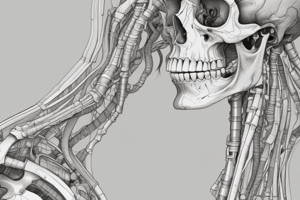Podcast
Questions and Answers
Match the following bones with their corresponding views in the skull:
Match the following bones with their corresponding views in the skull:
Frontal bone = Anterior view Occipital bone = Lateral view Parietal bone = Superior view Sphenoid bone = Inferior view
Match the following anatomical features with their corresponding bones:
Match the following anatomical features with their corresponding bones:
Alveolar process = Maxilla Mandibular fossa = Sphenoid bone Zygomatic arch = Frontal bone Palatine process = Palatine bone
Match the following sutures with their corresponding locations in the skull:
Match the following sutures with their corresponding locations in the skull:
Coronal suture = Frontal bone and parietal bone Sagittal suture = Two parietal bones Lambdoid suture = Parietal bone and occipital bone None of the above = Frontal bone and nasal bone
Match the following parts of the mandible with their corresponding descriptions:
Match the following parts of the mandible with their corresponding descriptions:
Match the following parts of the sternum with their corresponding descriptions:
Match the following parts of the sternum with their corresponding descriptions:
Match the following parts of the ribs with their corresponding descriptions:
Match the following parts of the ribs with their corresponding descriptions:
Match the following types of vertebrae with their corresponding descriptions:
Match the following types of vertebrae with their corresponding descriptions:
Match the following anatomical features with their corresponding parts of the vertebral column:
Match the following anatomical features with their corresponding parts of the vertebral column:
Match the following anatomical features with their corresponding parts of the skull:
Match the following anatomical features with their corresponding parts of the skull:
Flashcards are hidden until you start studying
Study Notes
Skull
- Anterior view: composed of frontal bone, nasal bone, zygomatic bone, maxilla, and alveolar process of maxilla
- Superior view: consists of frontal bone, parietal bone, occipital bone, coronal suture, sagittal suture, and lambdoid suture
- Lateral view: composed of frontal bone, parietal bone, squamous part of temporal bone, occipital bone, coronal suture, mastoid process of temporal bone, and zygomatic arch
- Inferior view: consists of palatine process of maxilla, palatine bone, sphenoid bone, mandibular fossa, mastoid process, occipital condyle, foramen magnum, and external occipital protuberance
- Cranial cavity: consists of anterior cranial fossa, sella turcica, petrous part of temporal bone, middle cranial fossa, posterior cranial fossa, and foramen magnum
Mandible
- Consists of head of mandible, ramus, angle of mandible, and body of mandible
Sternum
- Composed of manubrium sterni, sternal angle, costal cartilage of second rib, body of sternum, and xiphoid process
Ribs
- Consist of head, neck, tubercle, shaft, angle, costo-chondral junction (costal notch), and costal groove
- 1st rib has distinct features
Vertebral Column
- Composed of cervical vertebrae, thoracic vertebra, lumbar vertebra, sacrum, and coccyx
- Cervical vertebrae include atlas (1st cervical vertebra) and axis (2nd cervical vertebra) with a dens of axis
- Vertebral column includes C1 and C2 vertebrae
Studying That Suits You
Use AI to generate personalized quizzes and flashcards to suit your learning preferences.




